 Port Credit Marine Survey & Yacht Delivery From Ontario, Canada  Society of Accredited Marine Surveyors 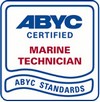 American Boat & Yacht Council 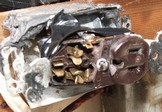 electrical tape repair ! 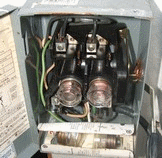 No, No, No AC fuses !  Neutral to ground - No !!! . 
|
AC polarity indicators and G.F.C.I's Polarity indicators -Often ignored and rarely checked. Some older boats with AC electrical systems
installed by less than expert hands are fitted
with single pole main breakers but not fitted
with a polarity indicator light. You must
also remember that even if your boat is wired
correctly, the shorepower pedestal may not
be. |
|||
|
With proper polarity If a fault occurs in
one of the loads (like a ground fault/short
circuit) , the current will increase
substantially
on the hot line which should trigger
the
branch supply circuit breaker for the
load
to trip. That's the main purpose for
having
the ground system installed (to ensure
there
is a path for fault currents to go
so that
the current will become high enough
to trip
the breaker, at the same time keeping
the
voltage down on the exterior of the
faulted
component). In a reverse polarity situation, when a ground fault occurs, the current rises substantially on the neutral line, If there is no breaker in the neutral line ( single pole), the conductor will heat up, cook, and could eventually cause a fire. That's why we have polarity indicators. They tell us there is no over current protection for the neutral conductor. ABYC® requires that you have a double pole mainbreaker or a single pole with a polarity indicator. This will protect the main line at the panel but a branch line to an AC outlet may also be reversed and this would not trigger the polarity indicator. For a few dollars you can buy one of the little testers shown in photo #4 and check all your AC outlets for correct polarity. If you don't have a polarity indicator, get one installed. If you have a single pole main breaker change it out for a double pole breaker. G.F.C.I. - Same old, same old - Often ignored and rarely checked. A ground-fault circuit interrupter is different than a circuit breaker in that its designed to protect you where a circuit breaker or fuse is there to protect the electrical conductors. ABYC® standards (and common sense) require that you have such protection anywhere there is potential for splash or spray i.e. galley, head, cockpit etc. When you look at a normal 120-volt outlet, there are two vertical slots and then a round hole centered below them. The left slot is slightly larger than the right and is called "neutral" (white conductor) the right slot is called "hot" (black conductor) and the hole below them is called "ground" (green conductor). If an appliance is working properly, all electricity the appliance uses will flow from hot to neutral. A GFCI monitors the amount of current flowing from hot to neutral. Basic electrical theory says that whatever voltage goes in must equal what is going out. If there is any imbalance (fault) then that difference is going somewhere it was not intended to and the G.F.C.I. trips the circuit breaker. It is able to sense a mismatch as small as 4 or 5 milliamps, and it can react as quickly as one-thirtieth of a second. Photo #3 shows a G.F.C.I. outlet in my galley. It has a small indicator light to show that it has power and it has a test and a reset button. I test all such outlets in my surveys and find that a majority do not function properly. The test and reset buttons need exercise as it takes very little corrosion to render them useless. Cycle these buttons at least monthly and if they neither trip nor reset, replace the outlet. Not all protected outlets have the indicator lights or test buttons. Downstream outlets on the same circuit are protected by the upstream G.F.C.I. To ensure that downstream outlets are connected through a G.F.C.I. you can buy a three light tester with a G.F.C.I. test button for just a few dollars and ensure that the outlet in the head/shower/cockpit are protected. Photo #4 shows that the outlet in my head is protected (downstream of galley outlet). Pick up one of these testers at any home improvement outlet for under $10.00 and while your at it check all your outlets at home too. G.F.C.I. outlets do not last forever. in the moisture laden environment of a boat they may last only a couple of years. Test and reset them occasionally to ensure they are still doing their job. If you are concerned for the safety of your crew I recommend you also take a look at Hot Docks & Electric Schock Drowing . |
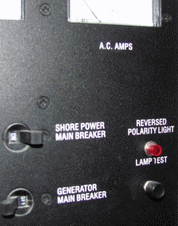 Photo #1 single pole with polarity indicator 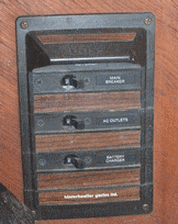 Photo#2 single pole without polarity indicator  Photo #3 G.F.C.I. outlet 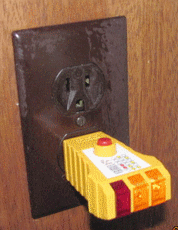 Photo #4 Downstream G.F.C.I. protected |
|||
| Wallace Gouk Society of Accredited Marine Surveyors AMS ret'd ABYC® Standards Certified ret'd ABYC® Certified Marine Corrosion ret'd ABYC® Certified Marine Electrical ret'd Transport Canada Licensed Master ret'd Transport Canada Tonnage Measurer BoatUS® Approved Marine Surveyor A Marine Surveyor for Ontario from Mississauga, Toronto, Hamilton to Oshawa, Whitby, Newcastle, Pickering, Trenton, Kingston, Gananoque and beyond |
||||